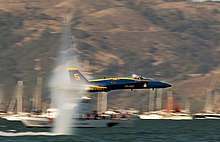Sea skimming
Sea skimming is a technique many anti-ship missiles and some fighter or strike aircraft use to avoid radar, infrared detection, and to lower probability of being shot down during their approach to the target.

Method
Sea-skimming anti-ship missiles try to fly as low as is practically achievable, which is almost always below 50 meters (150 ft), and is often down towards 2 meters (6 ft). When under attack, a warship can detect sea-skimming missiles only once they appear over the horizon (about 28 to 46 km from the ship), allowing about 25 to 60 seconds of warning.[1][2]
Advantages
By flying low to the sea, missiles decrease the range at which the target ships can detect them by a significant amount. Flying at a lower altitude increases the amount of time the missile is under the horizon from the perspective of the target ship, making it harder to detect due to radar clutter from the sea and similar effects. The real-life success of sea skimming depends on its exact implementation, the sophistication of the detection equipment, as well as the infrared and radar signature of the missile. Sea skimming can significantly reduce the available response time that a ship's missile defenses have to work within, making these missiles significantly harder to defend against. Sea skimming can also increase the range of a missile, by relying on ground effects.
Disadvantages
The use of sea skimming increases the risk of water impact with the missile before reaching the target, due to weather conditions, rogue waves, software bugs and other factors. Sea skimming also hinders target acquisition, as many of the principles that hinder the target's detection of the missile also hinder the missile's detection of the target. Furthermore, sea skimming involves a significant computational load, increasing the required processing power and cost.
Possible defenses
Phalanx CIWS
The Phalanx CIWS (close-in weapons system) is an automated, high-speed defense against anti-ship missiles, designed and manufactured by General Dynamics (now a part of Raytheon). Consisting of a radar-guided 20 mm (0.79 in) Gatling gun mounted on a swiveling base, the Phalanx is used by the United States Navy on every class of surface combat ship, by the United States Coast Guard aboard its Hamilton-class and Legend-class cutters, and the navies of 16 allied nations. Its effective range is very short relative to the range of modern ASMs, from 1 to 5 nautical miles (9 km).
The CIWS is designed to be the last line of defense against anti-ship missiles. An entirely self-contained unit, the system houses the gun, an automated fire control system and all other major components, enabling it to autonomously search for, detect, track, engage and confirm kills using its computer-controlled radar system with minimal human oversight. The system takes minimal inputs from the ship, making it capable of functioning despite potential damage to the ship.
The mount moves at a very high speed and with great precision, firing projectiles at a rate of 4,500 rounds per minute from a 1,550-round magazine. The velocity of the rounds once fired is approximately 3,600 feet per second (1,100 m/s). The rounds are armor-piercing tungsten penetrator rounds or depleted uranium with discarding sabots. The kinetic projectiles are designed to pierce and explode an incoming missile's warhead. The ammunition handling system has two conveyor belt systems.
SeaRAM
Utilising the armament of the RIM-116 Rolling Airframe Missile and based on the mounting and targeting systems of the Phalanx, SeaRAM was developed in response to concerns about the performance of gun-based systems against modern supersonic sea-skimming anti-ship missiles. Designed as a companion self-defense system to Phalanx,[3] the SeaRAM is equipped with an 11-cell RAM launcher and provides defense at a longer range. Due to the common mounting, SeaRAM inherits the relatively easy installation characteristics of its gun-based sibling, with Raytheon stating that SeaRAM "fits the exact shipboard installation footprint of the Phalanx, uses the same power and requires minimal shipboard modification".
The SeaRAM combines the radar and electro-optical system[4] of the Phalanx CIWS Mk-15 Block 1B with an 11-cell RAM launcher to produce an autonomous system — one which does not need any external information to engage threats. Like the Phalanx, SeaRAM can be fitted to any class of ship. It is still in trial stages and not currently being procured by the US Navy.[5]
In 2008, a SeaRAM system was delivered to be installed on USS Independence (LCS-2).[6]
Use in major wars
French-made Exocet missiles were used by Argentina in the Falklands War (including the scuttling of HMS Sheffield) and by Iraq against the USS Stark in the Persian Gulf during the Iran–Iraq War. The Argentinian pilots of the Super Étendard planes that attacked HMS Sheffield were also skimming the sea at very low level. They increased their altitude only for a very short period to get final target information for the attack with their Agave radars.
References
- "Archived copy". Archived from the original on 2012-05-05. Retrieved 2012-05-18.CS1 maint: archived copy as title (link)
- "Archived copy" (PDF). Archived from the original (PDF) on 2006-08-20. Retrieved 2006-08-10.CS1 maint: archived copy as title (link)
- Raytheon. SeaRAM datasheet.
- Norman Polmar (2005). Ships and Aircraft of the U.S. Fleet. The Naval Institute. p. 519.
- "SeaRAM datasheet" (PDF). Raytheon. Retrieved 15 September 2010.
- "Raytheon Company has delivered its SeaRAM anti-ship missile defense weapon system for installation aboard the littoral combat ship USS Independence (LCS-2)" (Press release). Raytheon. Archived from the original on 6 June 2011. Retrieved 15 September 2010.